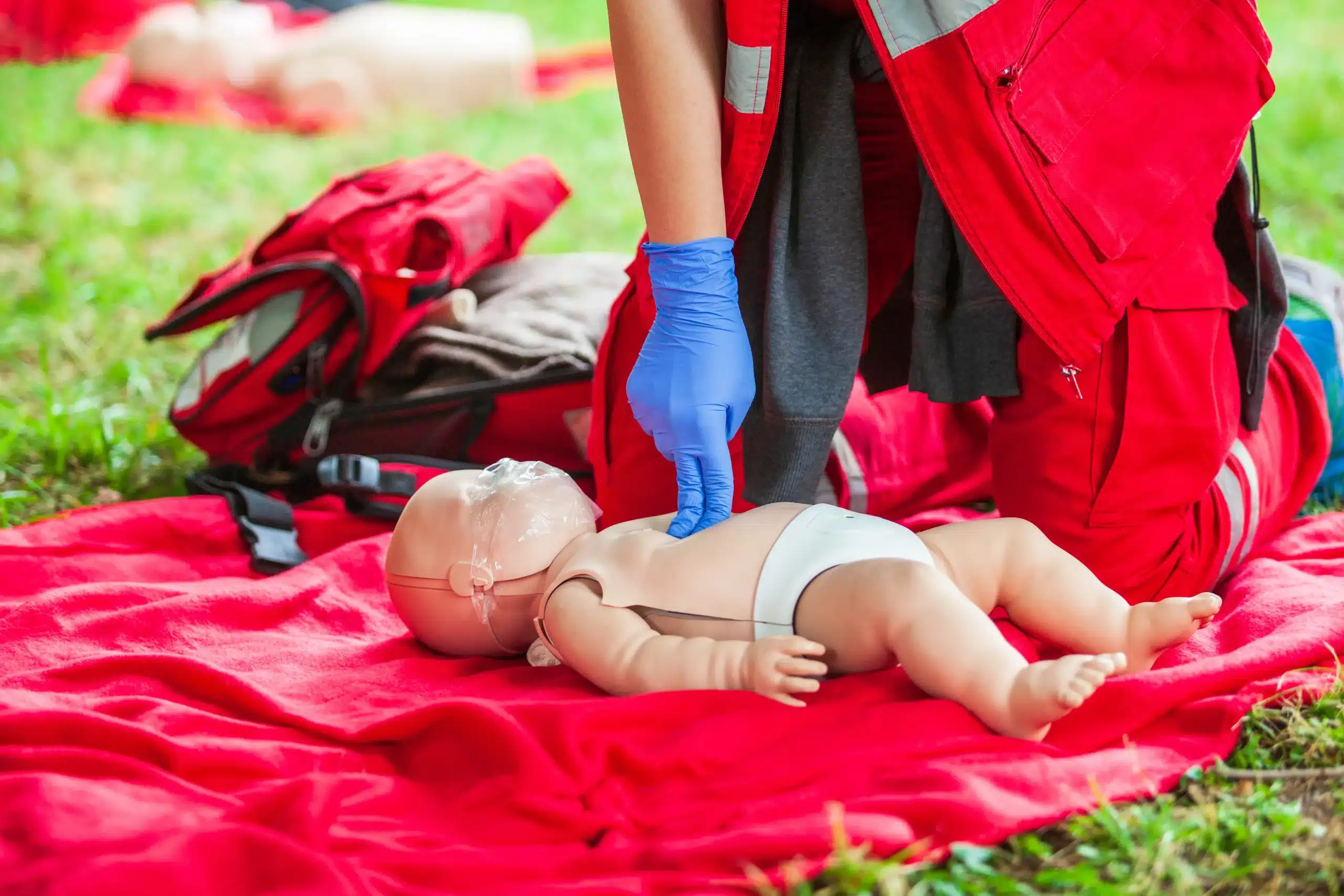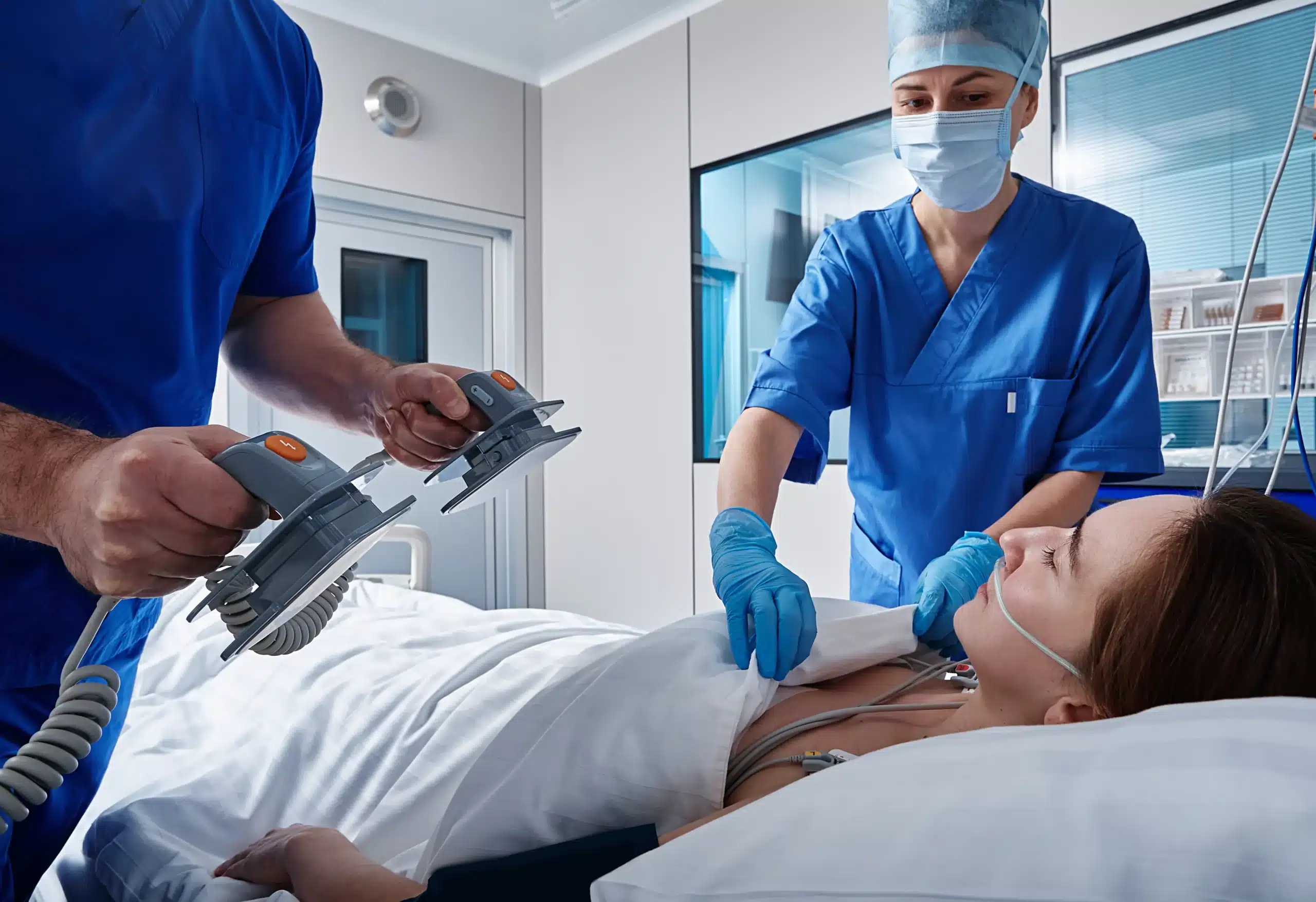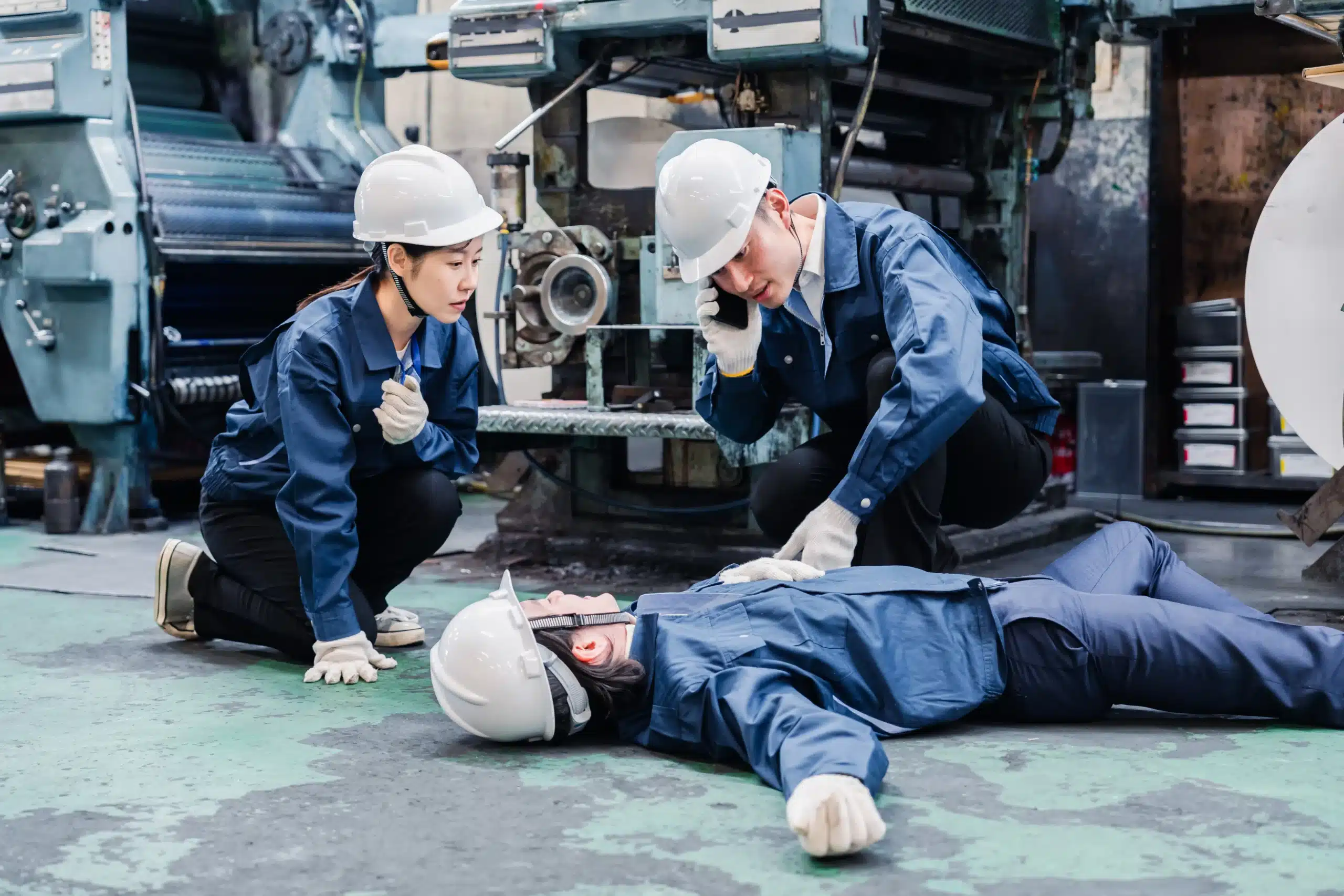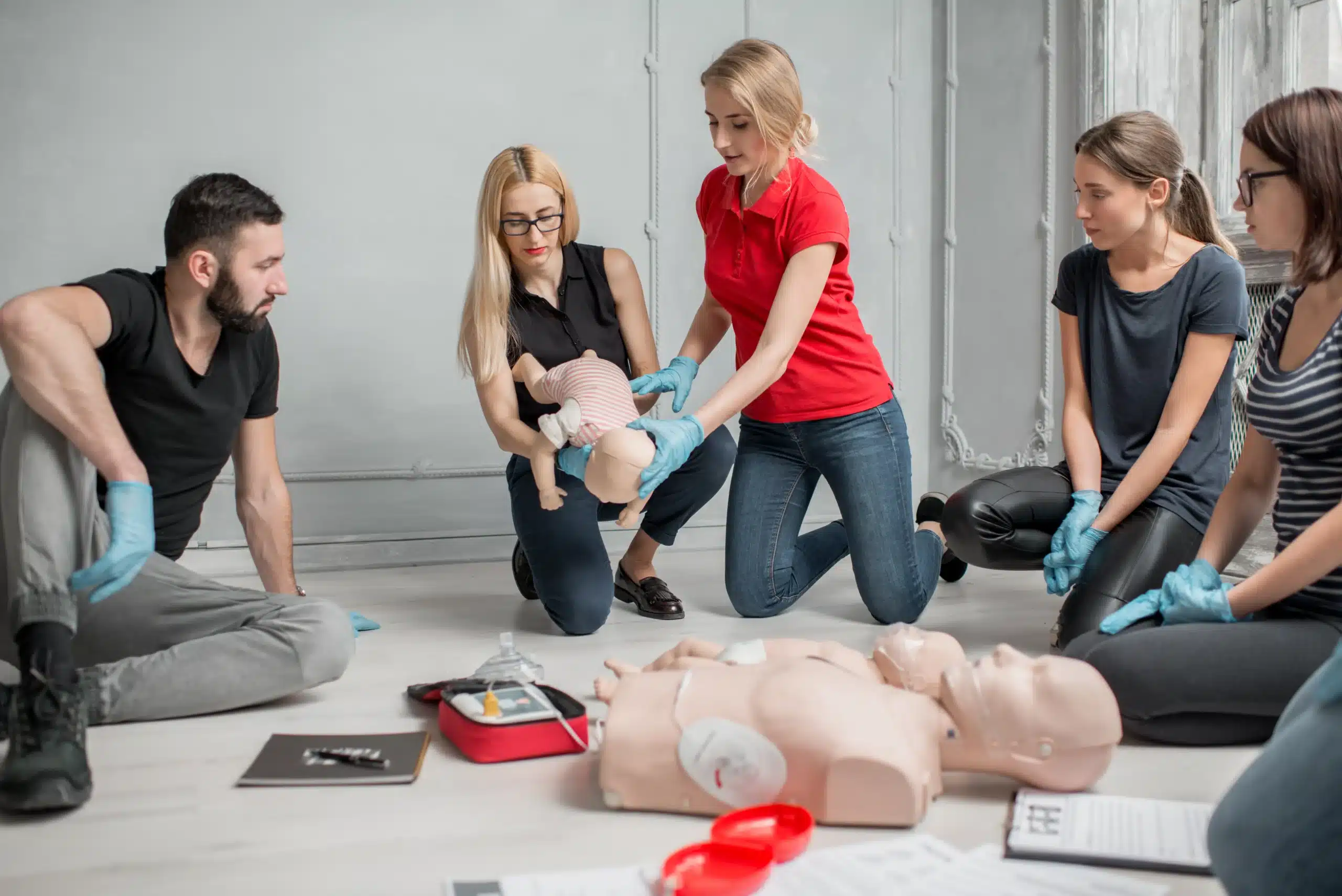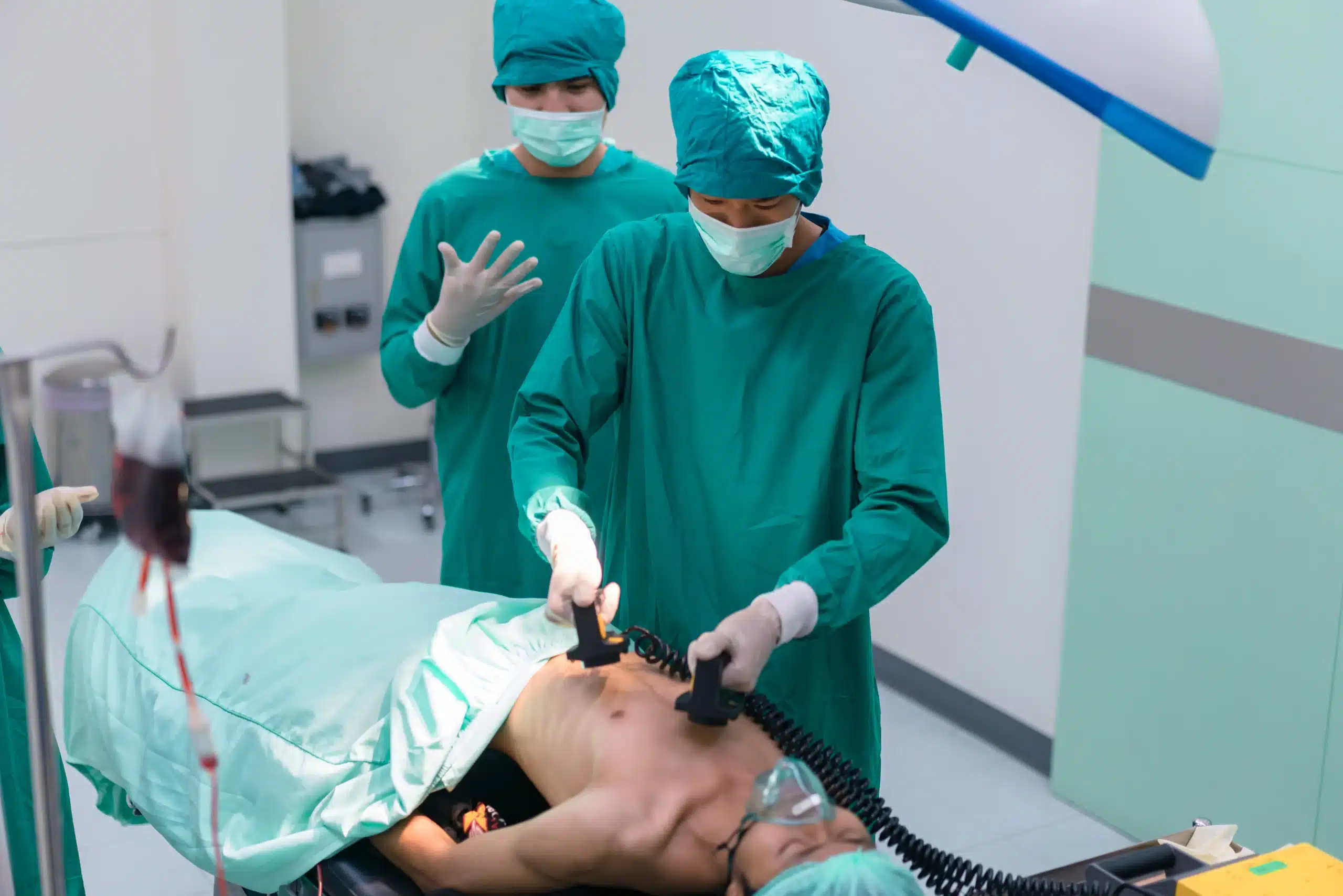Emergencies can happen anytime, anywhere. Would you know what to do if someone near you experienced sudden cardiac arrest? Learning CPR can give you the confidence and skills to respond effectively in such critical situations. This guide provides a complete overview of CPR training, including how to find cardio pulmonary resuscitation nearby, the different types of CPR classes available, and what to expect during the training process. We’ll also discuss the costs associated with CPR certification and how it contributes to building safer, more prepared communities. Whether you’re seeking basic life support skills or advanced cardiac life support certification, this guide will help you take the first step towards becoming a lifesaver.
Key Takeaways
- CPR skills empower you to save lives: From basic to advanced, CPR training equips you to handle emergencies effectively. Explore options like BLS, ACLS, and PALS to find the right fit.
- Local CPR classes offer convenience and community: Learn alongside your neighbors and gain practical skills applicable to your area. Providers like Safety Training Seminars offer accessible, high-quality training.
- CPR-trained communities are safer communities: Become a vital link in the chain of survival. CPR certification benefits not only you but also strengthens your community’s ability to respond to emergencies.
What is CPR?
CPR, which stands for Cardiopulmonary Resuscitation, is a lifesaving technique used when someone’s heart stops beating. It’s an emergency procedure that helps maintain blood flow to the brain and other vital organs until professional medical help arrives. Learning CPR empowers you to make a real difference in a critical situation. The American Heart Association emphasizes that immediate CPR can double or even triple the chances of survival after cardiac arrest. CPR training provides you with the skills and confidence to respond effectively in such emergencies.
Key CPR Components
There are two main types of CPR: traditional CPR with rescue breaths and Hands-Only CPR. Hands-Only CPR focuses on continuous chest compressions, performed at a rate of 100-120 compressions per minute. This method is often recommended for untrained individuals or those who are uncomfortable with mouth-to-mouth resuscitation, as highlighted by the Mayo Clinic’s CPR guide. Traditional CPR follows the CAB sequence: Compressions, Airway, Breathing. This involves chest compressions combined with opening the person’s airway and providing rescue breaths. This more comprehensive approach requires formal training to perform correctly.
When to Perform CPR
CPR should be performed when someone is unresponsive and not breathing normally. If you’re unsure whether someone needs CPR, it’s always better to err on the side of caution and begin CPR. Prompt action is crucial in these situations. Even if you’re not completely certain, attempting CPR can significantly improve a person’s chances of survival. The Mayo Clinic stresses that any attempt at CPR is better than no attempt at all. Your quick thinking and willingness to act could save a life.
Find CPR Classes Near You
Knowing where to find CPR training is the first step in becoming equipped to handle emergencies. This section breaks down different avenues for CPR certification, from national organizations to local resources.
Organizations Offering CPR Training
Several well-regarded organizations offer standardized CPR training programs. The American Red Cross provides a range of CPR classes designed to meet diverse needs and schedules. Similarly, the American Heart Association offers numerous courses, including online options for flexible learning. For those in and around Milpitas, California, Safety Training Seminars offers various American Heart Association certification courses, including BLS, ACLS, PALS, and First Aid seven days a week.
Online Class Resources
Online learning has made CPR certification more accessible. The American Heart Association’s eLearning platform allows students to learn at their own pace and complete the coursework from anywhere with internet access. This format is particularly helpful for those with busy schedules or limited access to in-person classes. Online resources are also valuable tools for companies and organizations looking to train multiple employees or volunteers.
Top Local CPR Trainers
Beyond national organizations, local resources often provide CPR training.
American Red Cross
Check your local Red Cross chapter website for class schedules and availability. They frequently offer in-person training within communities.
American Heart Association
While the AHA offers online resources, they also have a network of training centers. Use their website to locate certified instructors near you.
Safety Training Seminars
Serving Milpitas, San Jose, and Santa Clara, Safety Training Seminars provides convenient, local access to CPR and first aid training. They offer a variety of courses, including BLS, ACLS, and PALS.
Local Fire Departments and Hospitals
Many fire departments and hospitals offer CPR classes to the public. Contact your local fire department or hospital to inquire about available courses and schedules. Availability varies, so check directly with these organizations.
CPR Class Types
Knowing which CPR class is right for you can feel overwhelming with so many options. This section breaks down the most common types, from basic to advanced, so you can choose the best fit.
Basic Life Support (BLS)
BLS certification goes beyond basic CPR. It covers a wider range of life-saving skills for healthcare providers, including using a bag valve mask, two-rescuer CPR, and how to relieve choking. BLS classes teach students how to recognize life-threatening emergencies, provide high-quality chest compressions, deliver appropriate ventilations, and use an AED early. In Milpitas, you can find BLS certification courses for around $70 through providers like Safety Training Seminars. These courses meet the American Heart Association (AHA) guidelines and provide an official AHA BLS certification card upon successful completion.
Advanced Cardiac Life Support (ACLS)
ACLS certification is designed for healthcare professionals who manage cardiopulmonary arrest and other cardiovascular emergencies. It builds upon the foundational skills learned in BLS, adding complex algorithms for treating specific conditions like stroke and heart attack. ACLS training emphasizes effective teamwork, communication, and high-performance resuscitation techniques.
Pediatric Advanced Life Support (PALS)
PALS focuses on the specialized needs of infants and children facing respiratory or cardiac emergencies. Like ACLS, PALS is geared towards healthcare providers and builds on the core skills of BLS. It teaches participants how to recognize and respond to life-threatening situations in young patients, including effective airway management and medication administration. Safety Training Seminars offers a variety of American Heart Association courses, including PALS, in Milpitas.
Heartsaver CPR/AED
Heartsaver courses are ideal for anyone wanting to learn basic CPR and how to use an automated external defibrillator (AED). These courses are suitable for community members, teachers, and workplace responders. They cover essential life-saving techniques for adults, children, and infants, including choking relief. Several organizations in Milpitas, including First Support CPR and First Aid Training and ICE Safety Solutions, offer Heartsaver CPR/AED classes.
Hands-Only CPR
Hands-Only CPR is a simplified technique recommended for people who aren’t formally trained or comfortable with traditional CPR involving rescue breaths. It focuses on continuous chest compressions at a rate of 100-120 beats per minute. While Hands-Only CPR is a valuable skill for bystanders, conventional CPR with rescue breaths remains the preferred method for trained responders. Learn more about Hands-Only CPR from reputable sources like the Mayo Clinic.
What to Expect in a CPR Class
CPR training empowers you to save lives. From basic CPR to advanced life support, certifications like BLS, ACLS, and PALS equip you with the skills to respond effectively to medical emergencies. Let’s break down what you can expect during your CPR class.
Course Content
CPR classes cover essential life-saving techniques and knowledge. You’ll learn how to recognize the signs of a cardiac arrest, when to call for help, and how to deliver effective chest compressions and rescue breaths. Courses often include instruction on using an automated external defibrillator (AED) and choking relief techniques. The curriculum typically follows American Heart Association (AHA) guidelines, ensuring you receive up-to-date training. For more details, check out our BLS course page. We also offer ACLS and PALS courses for healthcare providers seeking advanced certifications.
Hands-on Practice
CPR classes aren’t just lectures. A significant portion of your training involves hands-on practice. You’ll work with mannequins to simulate real-life scenarios, allowing you to develop muscle memory and confidence in performing CPR. Safety Training Seminars provides this crucial hands-on experience in our Milpitas location, giving you the practical skills you need to act quickly and effectively in an emergency. We offer flexible scheduling options, including weekday and weekend classes.
Certification Process
Upon successful completion of your CPR course, you’ll receive an official certification card. This card validates your training and demonstrates your ability to perform CPR. After finishing your BLS course, you’ll receive an American Heart Association (AHA) BLS certification card, which is nationally recognized. This certification is typically valid for two years, after which you’ll need to take a refresher course to maintain your skills and credentials. We offer convenient renewal courses to help you stay current with your CPR certification.
CPR Training Costs and Certification
Knowing the price range for CPR training and how certification works can help you plan for your course. Let’s break down the typical costs, potential discounts, and what to expect with your certification.
Average Prices
CPR training costs vary, but a good starting point is around $35 per person for a two-hour course covering CPR and AED use. This is a general estimate, and prices can differ based on location and the training provider. For businesses wanting to train a team, group bookings are often available. You can usually book a class for a minimum of eight students for about $280 total, a more economical option per person. For local cost estimates, check out CPR training lessons in your area.
Discounts and Group Rates
Many CPR training providers offer discounts for group bookings, making it more affordable to train your entire team or organization. For example, Santa Clara CPR Classes offers American Heart Association BLS certification for around $70 per person, but this price often decreases with larger groups. Check with your chosen provider for specific group rates and any other discounts.
Certification Validity and Renewal
After successfully completing your BLS course, you’ll receive an American Heart Association (AHA) BLS certification card. This card is your proof of training and is widely recognized. Keep in mind that these certifications are typically valid for two years. You’ll need to renew your certification to stay current with the latest guidelines and maintain your skills. CPR courses are readily available to help you stay certified. Providers like Safety Training Seminars offer various AHA certifications, including BLS, ACLS, PALS, CPR, and First Aid, making it easy to find the right course for your needs.
Choose the Right CPR Class
Deciding to learn CPR is a great first step. Now, it’s time to find the right class for you. This section will guide you through choosing a CPR class that aligns with your individual needs and goals.
Factors to Consider
Several factors come into play when selecting a CPR class. Think about your learning style, schedule, and specific requirements. CPR training is available in online, in-person, and blended formats. Online-only CPR courses offer flexibility and self-pacing, but they typically don’t include hands-on skill demonstrations. In-person training provides this crucial practice. Online-only certification may not meet all workplace requirements, so check with your employer if CPR certification is a job requirement. Blended learning combines online convenience with the benefits of in-person practice.
Matching Needs with Class Options
Once you’ve considered the learning formats, you can narrow down your options. If your workplace requires CPR certification, a blended or in-person course is usually best. For healthcare professionals, look for courses like BLS, ACLS, or PALS. If your job requires CPR certification, but you don’t work in healthcare, a Heartsaver CPR/AED class might be a good fit. Consider what you want to achieve with your training. Are you looking for basic life support knowledge or more advanced skills? Do you need certification for a specific job or personal enrichment? Answering these questions will help you find the perfect match. For those in Milpitas, San Jose, and Santa Clara, Safety Training Seminars offers various CPR courses through the American Heart Association. They also provide the RQI program for medical professionals seeking to maintain their resuscitation skills.
CPR Training’s Impact on Community Health
Survival Rates and Bystander Intervention
Cardiac arrest is a serious medical emergency, affecting roughly half a million people in the United States each year. Studies show that bystander CPR can dramatically improve survival rates, sometimes doubling or even tripling a victim’s chances of surviving an out-of-hospital cardiac arrest. Even if you feel unsure about your skills, attempting CPR is always better than doing nothing at all. The Red Cross emphasizes that any attempt at CPR increases the likelihood of a positive outcome. For a refresher on the basics, the Mayo Clinic offers a helpful guide to CPR. This highlights how crucial widespread CPR training is for our communities. The American Heart Association provides more information on CPR facts and statistics.
Building Safer Communities
Learning CPR isn’t just about individual preparedness; it’s about building a network of lifesavers within our communities. CPR skills become a shared resource, empowering individuals to respond effectively during emergencies. While many communities offer CPR training through their local fire departments, the availability of these classes can vary. Don’t wait for an emergency; take the initiative to find a CPR course. Articles like this one on CPR courses in Milpitas can offer helpful guidance. By having more people trained in CPR, we create a culture of readiness and responsiveness, making our communities safer for everyone. CPR training creates a ripple effect, empowering individuals and strengthening the overall health and safety of our communities.
Enroll in a CPR Class Today
Ready to become CPR certified? It’s easier than you think. Here’s how to sign up for a class and what to expect:
Steps to Sign Up
-
Find Local Classes: Start by exploring CPR class options near you. Online directories like Yelp can help you discover local providers like ICE Safety Solutions, First Support CPR and First Aid Training, and the American Red Cross. For those in the Milpitas, CA area, Safety Training Seminars offers various American Heart Association courses.
-
Choose the Right Course: CPR certifications vary, so determine which type best suits your needs. Do you need basic CPR training or a more advanced certification like BLS for healthcare providers? Safety Training Seminars offers various courses, including BLS, ACLS, PALS, and CPR/First-aid, allowing you to choose the best fit.
-
Contact the Provider: Once you’ve identified a few training centers, contact them directly to discuss class schedules, costs, and availability. Many providers offer flexible scheduling to accommodate busy schedules.
Preparing for Your Class
-
Understand the Costs: CPR training fees vary based on the course type and provider. Knowing the cost upfront helps you budget accordingly. Some providers may offer group discounts.
-
Gather Necessary Materials: Most training providers supply all necessary materials. Double-check with your chosen provider to confirm and ensure you’re prepared for class. You’ll receive a certification card upon successful completion, like those from the American Heart Association.
-
Plan Ahead: Register in advance, especially if you need a class at a specific time. Early registration is key for popular dates and times. Some providers offer on-site training, a convenient option for larger groups.
Community Benefits of CPR Training
CPR training goes beyond individual skill development; it significantly contributes to the overall health and safety of our communities. By increasing emergency preparedness and empowering individuals to save lives, CPR training creates a ripple effect of positive change.
Increase Emergency Preparedness
CPR and first-aid training equips individuals with the knowledge and skills to respond effectively in emergencies. These skills are invaluable anywhere, from homes and workplaces to public spaces. Having trained individuals readily available increases the chances of timely intervention during medical crises. Even basic CPR knowledge can make a life-saving difference, bridging the gap before professional medical help arrives. This immediate response can significantly improve outcomes, especially in cases of cardiac arrest where every second counts. Preparedness through training creates more resilient communities, better able to handle unexpected medical emergencies. For more information on CPR and first-aid classes, check out these resources from Bay Area CPR. The Mayo Clinic also offers helpful information on the basics of first aid.
Empower Individuals to Save Lives
CPR training empowers individuals to take direct action and potentially save lives. Certifications like BLS, ACLS, and PALS provide the skills to respond effectively to various medical emergencies, from basic CPR to advanced life support. Knowing how to perform CPR instills confidence and reduces hesitation in critical moments. This empowerment transforms bystanders into potential lifesavers. Hundreds of thousands of cardiac arrests occur each year in the US. Bystander CPR can dramatically increase survival chances. This fact highlights the importance of widespread CPR training. The Red Cross offers CPR training courses to help you become equipped to handle these situations. For a guide to CPR courses in the Milpitas area, Santa Clara CPR Classes provides helpful information.
Why Choose Local CPR Classes?
When it comes to learning CPR, opting for a local class offers distinct advantages that online courses or distant training centers often can’t match. These benefits extend beyond the classroom and contribute to a stronger, more prepared community.
Convenience and Accessibility
Local CPR classes, like those offered by Safety Training Seminars in Milpitas, prioritize convenience. Their central location, coupled with a wide range of class times, makes attending a class manageable, even with a busy schedule. This accessibility is crucial for residents of Milpitas, San Jose, and Santa Clara, eliminating the need for lengthy commutes. Finding a class that fits your schedule and is easy to reach increases the likelihood of completing your training and gaining this life-saving skill.
Immediate Skill Application
Learning CPR empowers you to make a real difference in your community. From basic CPR to more specialized certifications like BLS, ACLS, and PALS, these courses equip you with the skills to respond effectively to medical emergencies. Local classes often focus on the specific needs and challenges of the area, making your training even more relevant. This means you’re not just learning CPR in theory; you’re gaining practical knowledge you can apply directly within your community. CPR and first-aid certification courses can prepare you for a variety of situations. You can find more information on CPR and first-aid training on the Safety Training Seminars website.
Build Local Support Networks
Taking a local CPR class connects you with other community members who share your commitment to emergency preparedness. This shared experience creates a valuable support network. You’ll meet people who understand the importance of CPR and can offer encouragement as you continue to practice and maintain your skills. Plus, being trained alongside others in your community fosters a sense of collective responsibility for safety and well-being. Check out resources like Yelp to discover CPR training options and connect with local providers. Building these connections strengthens your community’s ability to respond effectively in emergencies.
Related Articles
- CPR Training in Santa Clara: A Complete Guide – Milpitas CPR Classes
- Why CPR Is Vital in Healthcare & How to Get Certified
- Workplace CPR Certification in Milpitas: A Practical Guide – Milpitas CPR Classes
- Find CPR Certification Near Me: A Practical Guide – Milpitas CPR Classes
- Online CPR Classes in Milpitas: Your Complete Guide – Milpitas CPR Classes
Frequently Asked Questions
What’s the difference between Hands-Only CPR and traditional CPR? Hands-Only CPR focuses on continuous chest compressions, which is great for people who haven’t had formal training or are hesitant about rescue breaths. Traditional CPR involves both chest compressions and rescue breaths and is generally preferred for those who have received proper training. It’s more comprehensive but requires a bit more knowledge and practice.
How do I find a CPR class near me? Several organizations offer CPR training. The American Red Cross and the American Heart Association are excellent resources. You can also check with your local fire department, hospitals, or community centers. Online directories can help you find local providers, and searching for “[your city] CPR classes” is a good starting point. For those in or around Milpitas, California, Safety Training Seminars offers a range of courses.
Which CPR certification is right for me? The best CPR certification depends on your needs. If you’re a healthcare provider, you’ll likely need BLS, ACLS, or PALS. For general knowledge and community preparedness, a Heartsaver CPR/AED course is a good option. If you’re looking for the simplest approach, Hands-Only CPR might be sufficient, but remember, traditional CPR is generally recommended for those who can do it.
How much does CPR training cost? CPR training costs vary depending on the provider, location, and type of course. Basic CPR and AED training can start around $35, while more advanced certifications like BLS can be around $70. Many providers offer group discounts, so if you’re training with friends, family, or colleagues, be sure to ask about potential savings.
How long is a CPR certification valid, and how do I renew it? Most CPR certifications are valid for two years. To renew your certification, you’ll need to take a refresher course. This ensures your skills and knowledge are up-to-date with the latest guidelines. Contact your original training provider or another certified organization to find a renewal course near you.
